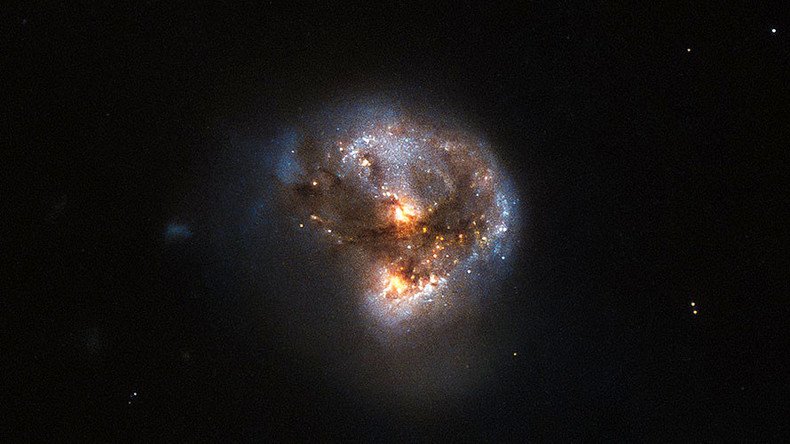Cosmic laser beam: Hubble captures image of intensely bright megamaser in far off galaxy (PHOTOS)

NASA’s Hubble telescope has captured a stunning shot of a galaxy more than 370 million light years from Earth that hosts an intensely bright megamaser.
A megamaser is some 100 million times brighter than masers found in galaxies like the Milky Way and acts as an astronomical laser that beams out microwave emission rather than visible light.
It is a naturally occurring source of stimulated spectral line emission, with greater luminosities than masers.
This megamaser galaxy snapped by Hubble named IRAS 16399-0937 is described by NASA as “more exciting and futuristic” than most.
Megamasers are around 100 million times brighter than the masers found in galaxies like our own Milky Way!
— Hubble (@NASA_Hubble) 29 декабря 2016 г.
READ: https://t.co/U27Nuh4w4bpic.twitter.com/EYSyrAhmh8
The image shows a beautiful serene celestial wonder, contrasting with the megamaser’s intense and energetic nature.
Two Hubble instruments – the Advanced Camera for Surveys (ACS), and the Near Infrared Camera and Multi-Object Spectrometer (NICMOS) – were used to record observations across various wavelengths.
Scientists were able to determine from use of the NICMOS that the galaxy hosts a double nucleus, essentially meaning that its core is likely the result of two separate cores that are in the process of merging.
Threat detected: #NASA 'space laser' detects eco-disaster in ocean https://t.co/7KGbK6f9QLpic.twitter.com/Xcohh3qI20
— RT (@RT_com) 22 декабря 2016 г.
The two components, named IRAS 16399N and IRAS 16399S for the northern and southern parts respectively, are separated by 11,000 light-years.
However, they are both buried deep within the same swirl of cosmic gas and dust, interacting with each other to create the galaxy’s peculiar structure, according to NASA.
The southern nucleus appears to be a starburst region where new stars are forming at an incredible rate, while the northern nucleus is a region whose emission mostly comes from weakly-ionized or neutral atoms of particular gases.
The northern nucleus also hosts a massive black hole with a mass some 100 million times that of the sun.












